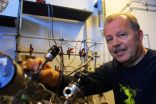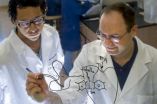(Press-News.org) (Santa Barbara, Calif.) –– A ballet dancer grasps her partner's hand to connect for a pas de deux. Later that night, in the dark, she reaches for her calf to massage a sore spot. Her brain is using different "maps" to plan for each of these movements, according to a new study at UC Santa Barbara.
In preparing for each of these reaching movements, the same part of the dancer's brain is activated, but it uses a different map to specify the action, according to the research. Planning to hold hands is based on her visual map of space. Her second plan, to reach for her calf, depends on the dancer's mental body map.
Two UCSB scientists studied the brains of 18 individuals who made 400 distinct arm reaches as they lay in an MRI scanner. The researchers found clear differences in brain planning activity with regard to the two types of reaching behavior. Their discovery is reported in the journal Neuron.
"Our results have two important applications," said Scott T. Grafton, professor of psychology. "One is robotics. The other is in the area of machine-brain interface; for example, in developing machines to help paraplegics. A critical issue is to understand how movement-related information is represented in the brain if we're to decode it." Grafton, a leading expert in brain imaging, directs the UCSB Brain Imaging Center where the university's MRI scanner is located.
"We're interested in movement planning and movement control," said Grafton. "We're looking at goal-directed behaviors, when we reach to grasp objects –– visually defined objects in our environment. This forms the basis of our interactions with the world."
The current scientific view is that all reaching movements –– those directed to visual targets or toward one's own body –– are planned using a visual map. "Our findings suggest otherwise," said Pierre-Michel Bernier, first author and postdoctoral fellow. "We found that when a target is visual, the posterior parietal cortex is activated, coding the movement using a visual map. However, if a movement is performed in darkness and the target is non-visual, the same brain region will use a fundamentally different map to plan the movement. It will use a body map."
The maps are located in a brain region called the precuneus, inside the parietal lobe. The researchers measured the "Blood Oxygen Level Dependent Signal," or BOLD signal, when looking at the MRI brain images. BOLD is an indirect way of looking at brain activity at a millimeter scale. They also used a methodology called "repetition suppression." This is what makes the study novel, according to the authors, as it is one of the first to identify where these maps are nested in the human brain. "We are a leader in the use of repetition suppression," said Grafton.
Repetition suppression relies on the fact that when a brain region is involved in two similar activities in a row, it is less active the second time around. The team was able to pinpoint the brain's use of body maps versus visual maps by isolating the location in the brain where the responses were less active with repeated, similar arm reaches.
Grafton explained: "The brain is trying to make a map of the world. One map is what you see, which is provided by the visual system. The other map is where the body is in space. This map is based on proprioception –– the sense of limb position –– which is derived from receptors in the skin, muscles, and joints. These maps are very different. How do you connect them? Either the visual map or the body map may be fixed, or neither may be fixed."
The authors' findings argue for the latter, demonstrating that the brain is capable of flexibly switching between these maps depending on the context. No doubt this flexibility underlies our ability to interact with the world with ease despite the ever-changing conditions in which our actions take place.
###
END
DENVER (December 2, 2010) – Fresh water and reusable energy. Humans are on a constant hunt for a sustainable supply of both. Water purification requires a lot of energy, while utility companies need large amounts of water for energy production. Their goal is to find a low-energy-required treatment technology. Researchers from the University of Colorado Denver College of Engineering and Applied Science may have discovered an answer.
Last year, a study published in Environmental Science & Technology incorporated desalination into microbial fuel cells, a new technology ...
Madrid, 2 december 2010.- Spanish Oncology has established a new standard treatment for Breast Cancer at early stages thanks to the results of the study 9805/Target 0 funded by Spanish Breast Cancer Research Group (GEICAM) and sponsored by Sanofi Aventis.
More than thousand patients and 50 hospitals participated in the study, whose findings are reported in the latest issue of The New England Journal of Medicine. Results indicate that docentaxel during quimotherapy reduces the risk of recurrence by 32% in women with high-risk but node-negative, early stage breast cancer ...
Agricultural – or Neolithic – economics replaced the Mesolithic social model of hunter-gathering in the Near East about 10,000 years ago. One of the most important socioeconomic changes in human history, this socioeconomic shift, known as the Neolithic transition, spread gradually across Europe until it slowed down when more northern latitudes were reached.
Research published today, Friday, 3 December 2010, in New Journal of Physics (co-owned by the Institute of Physics and the German Physical Society), details a physical model, which can potentially explain how the spreading ...
The use of androgen suppression therapy (AST) in prostate cancer for low-risk cases declined following a decrease in physician reimbursement, according to a study published online TK in The Journal of the National Cancer Institute. However, the indicated use of AST for metastatic disease in the palliative setting did not decline in the same period.
The use of AST in prostate cancer increased more than threefold between 1991 and 1999 both for patients with metastatic cancer and those with low-risk disease, but AST treatment in the latter group has not been shown to improve ...
Randomized phase III studies should be designed to find out whether a new drug or treatment makes a meaningful difference in patients' survival or quality of life, according to a commentary published online December 3rd in The Journal of the National Cancer Institute. Instead, most trials now are designed to detect a statistically significant difference between treatment and control groups, which may not be clinically meaningful, write Alberto Ocana, M.D., Ph.D. and Ian F. Tannock, M.D., Ph.D., of Princess Margaret Hospital in Toronto.
Regulatory agencies such as the ...
Improved standards for outcome reporting in breast reconstruction are needed, according to a review published online December 3rd in The Journal of the National Cancer Institute.
Every year in the United States up to 40% of women with breast cancer undergo a mastectomy. They say the most valuable factor in their decision-making is information from health professionals. However, that information is largely dependent on the quality, reporting, and interpretation of research data on surgical procedures.
To summarize the reporting standards of surgical outcomes in breast ...
While questions persist about the best ways to detect breast cancer early, a CT imaging system developed at the University of Rochester Medical Center and first unveiled five years ago is in a better position today to enter the fray -- at least in a supporting role to conventional mammography.
URMC radiologist Avice O'Connell, M.D., was invited to summarize the studies conducted thus far on the Cone Beam Computed Tomography (CBCT) scanner, at the Radiological Society of North America Annual Scientific Assembly in Chicago at 8:30 a.m. (EST) on Friday, December 3, 2010.
O'Connell ...
When doctors want their patients asleep during surgery they gently turn the gas tap. But Anaesthetic gasses have a global warming potential as high as a refrigerant that is on its way to being banned in the EU. Yet there is no obligation to report anaesthetic gasses along with other greenhouse gasses such as CO2, refrigerants and laughing gas.
One kilo of anaesthetic gas affects the climate as much as 1620 kilos of CO2. That has been shown by a recent study carried out by chemists from University of Copenhagen and NASA in collaboration with anaesthesiologists from the ...
Tampa, FL (Dec. 3, 2010) -- Dynamic regulation of the chaperone protein Hsp27 was required to get rid of abnormally accumulating tau in the brains of mice genetically modified to develop the memory-choking tau tangles associated with Alzheimer's disease, a University of South Florida-led study found.
Researchers at the USF Health Byrd Alzheimer's Institute demonstrated that the effective switching of Hsp27 between its active and deactivated states was critical on two fronts -- to promote the recycling of the tau protein in healthy nerve cells and to clear abnormal tau ...
Could information technology and data mining techniques be used to improve the diagnosis and treatment of depression? That's the question scientists in Australia hope to have answered in a forthcoming issue of the International Journal of Functional Informatics and Personalised Medicine.
Maja Hadzic, Fedja Hadzic and Tharam Dillon of the Digital Ecosystems and Business Intelligence Institute, at Curtin University of Technology, in Perth, explain how depression is rapidly emerging as one of the major health problems now facing society. They add that the World Health Organization ...

